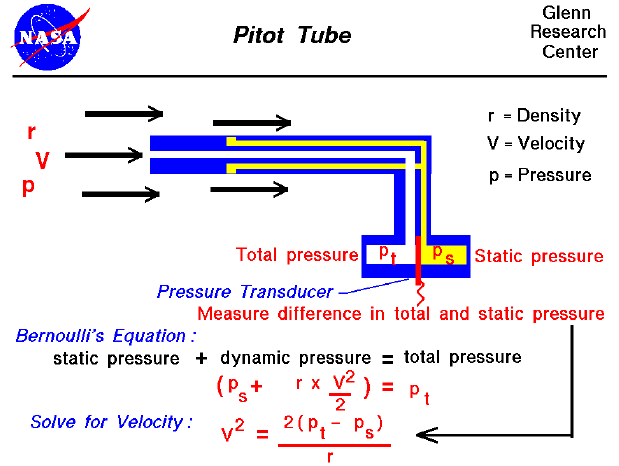

Pitot
Tube Problems
If so instructed by your teacher, print out a worksheet page for these problems.
If so instructed by your teacher, print out a worksheet page for these problems.

DEFINITIONS: Define the following terms.
- Force (F) -
- Mass (m) -
- Pressure (p) -
- Velocity (V) -
- Density (r) -
- UNIT ANALYSIS: Complete the table giving the correct unit of measurement in both the English and the Metric systems. You will use this information when solving the problems shown below.
|
|
|
|
|
|
|
|
|
|
|
|
|
|
|
|
|
|
|
|
|
|
|
|
|
|
|
|
|
|
|
|
|
|
|
|
*NOTE: For practical purposes, velocity is measured in KNOTS. One knot = 1.69 feet/second.
PROBLEMS: Solve each problem. Make sure all units agree!!
- Find the total
air pressure detected by the pitot tube for a Cessna 182 airplane
flying at a pressure altitude of 10,000 feet (static pressure of 1455.6
lb/ft2 ) and a speed of 120 knots if the air density is 0.00162
slugs/ft3.
- Find the difference
in pressure (pt-ps) for the same conditions described
above if the airplane speeds up to 160 knots.
- If the total air pressure for the same Cessna 182 is measured at 1478.7 lb/ft2, what is the new velocity in knots of the airplane?
HOME
EDUCATOR RESOURCES | AERONAUTIC EDUCATIONAL RESOURCES | INTERNET ACCESS RESEARCH | ICING RESEARCH TUNNEL
BEGINNER'S GUIDE TO AERONAUTICS | FREE SOFTWARE | AERODYNAMICS INFORMATION | AERODYNAMICS PROBLEMS | PROPULSION INFORMATION |
PROPULSION PROBLEMS | FOILSIM INFORMATION | FOILSIM PROBLEMS | ENGINESIM INFORMATION | ENGINESIM PROBLEMS | ROCKETMODELER
AERONAUTICS LESSONS & ACTIVITIES | WIND TUNNEL WEB PAGES | AERONAUTS 2000 | VIDEOCONFERENCES WITH THE U.K.
EDUCATOR RESOURCES | AERONAUTIC EDUCATIONAL RESOURCES | INTERNET ACCESS RESEARCH | ICING RESEARCH TUNNEL
BEGINNER'S GUIDE TO AERONAUTICS | FREE SOFTWARE | AERODYNAMICS INFORMATION | AERODYNAMICS PROBLEMS | PROPULSION INFORMATION |
PROPULSION PROBLEMS | FOILSIM INFORMATION | FOILSIM PROBLEMS | ENGINESIM INFORMATION | ENGINESIM PROBLEMS | ROCKETMODELER
AERONAUTICS LESSONS & ACTIVITIES | WIND TUNNEL WEB PAGES | AERONAUTS 2000 | VIDEOCONFERENCES WITH THE U.K.
Please send any comments to:
Curator: Tom.Benson@grc.nasa.gov
Responsible Official: Kathy.Zona@grc.nasa.gov
Curator: Tom.Benson@grc.nasa.gov
Responsible Official: Kathy.Zona@grc.nasa.gov